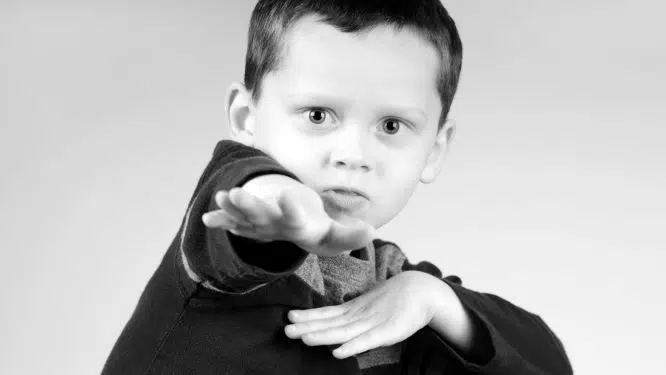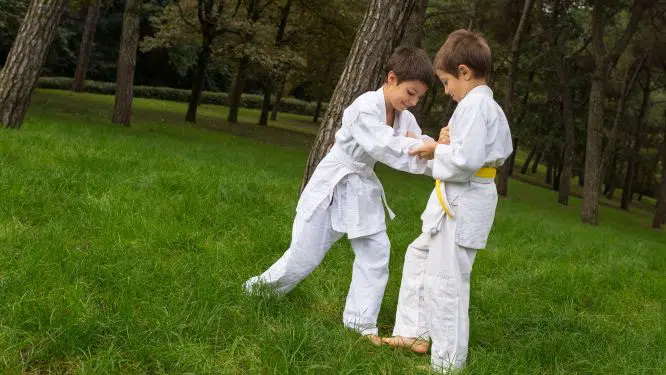I’ve been learning about karate and wondered whether it’s good for toddlers. I did some research and here’s what I found.
So, is karate good for toddlers? Karate isn’t good for toddlers until they reach about 2 years of age. Kids can begin to run around and do things like kick a ball at about 2 years old, according to Kidshealth.org. A child who is younger than that won’t have the motor skills yet to do karate.
There is a range of benefits that karate offers. And people often wonder whether karate will make a child aggressive, and what to look for when choosing a karate school.
So, below I’ll answer these questions and other helpful info about children doing karate at an early age.

Can a 2 year old do karate?
A 2 year typically has the motor skills needed to do the movements in karate, such as punching, kicking, blocking, running, and jumping. Certain karate schools have a toddlers program whereas others will only have a kids class. So, you’ll need to see if there’s one that offers it in your local area.
You could also go through online karate lessons with your child as a fun activity. Or your older kids, playmates, and/or cousins could do it with them if you play the lessons on the TV.
Most online courses are geared towards adults but classes offered by websites like Karate Lessons Online have a curriculum for all ages.
Physically, there aren’t many limitations that a 2-year-old has other than they are less coordinated. So, it can take them a little longer to learn the moves.
An older child by comparison will have better balance and has more ‘physical intelligence’ because they’ve been walking, running, and playing for longer than a 2-year-old.
2 years olds are also typically still in diapers, which can be a bit more difficult logistically. But nothing out of the ordinary, and a toddler’s class will be used to that.
At the age of 2 is around the age that children begin talking. But, even if they don’t yet it’s easy for them to understand, ‘do this and to copy what the bigger kids, the children their age, and the instructor are doing.
Should I put my kid in karate?
Having children engage in a sport is very healthy for them, and develops their social skills, as well as, values such as discipline, patience, and diligence. However, it’s important to get to know the karate school in-depth, as each has its own culture.
Some schools can have a bully culture, which will be detrimental to your child. And might not be apparent at first glance. It’s a good idea to sit in a few classes so that you’re not just getting their best behavior.
There are also many other martial arts or sports that children can ultimately do. And there is no one best sport. As you may be aware, children have different temperaments and may be better suited to different sports and martial arts.
For example, an outgoing extroverted child who likes to ruff and tumble might be better suited to wrestling, American football, or rugby.
Whereas, a more reserved shy child might be better suited to golf, or archery. Shy children are typically more introverted, intelligent, and like to spend time alone. So, individual sports are typically better suited to their personality, and they’ll enjoy them more.
Will karate make my child more aggressive?
There is no evidence to suggest that a child that trains karate will be more aggressive. According to Kidsmartialarts.com, learning karate decreases aggression. And there is a lot of anecdotal evidence to support this fact. Karate schools in general have a culture of treating people with kindness and respect.
I haven’t been able to find any studies that have looked specifically at this phenomenon, but based on what I’ve observed at my martial arts gym, it appears that karate makes children less aggressive, and more friendly.
There was one study, quoted in a Psychology Today article, which said that there’s a link between punching pads and increased aggression.
But, in my opinion, the results weren’t conclusive because they tested the participants immediately after they had been hitting the pads.
And as a result, they would have been in a fighting mindset.
If they had instead waited for an hour or so after they had hit the pads I think the results would have been different.
What is a good age to start karate?
Any age is a good age to start karate. When you’re younger your body heals faster, and you have more energy, which is helpful for physical activities like karate. But, the moves in karate are not overly complicated or physically demanding and can be learned at any age.
This is provided of course you don’t have any pre-existing injuries. And if you’re in doubt you should consult a doctor or physio.
But, like anything, it’s good to try a bunch of different things to see if you like it. One issue that can come up is if you sign up for a year’s membership and end up not liking it, or your personal situation changes.
This can be a bit of an issue, so it’s a good idea to fully understand how the membership works, and how flexible it is. It’s best to take a few lessons in the beginning for a month or two to see when you’re actually doing it how motivated you are.
I’ve seen a few guys start training at my martial arts gym, who were really into it and said they love it and want to go to every class. But, after about a month they stopped coming back.

Advantages of starting early
The main advantages of starting training karate early are:
- You will have more practice than other people, where they can’t catch up
- You will have a chance at being the best in the world
When you start training karate at an early age, over time you’ll get more practice than other people. Since everyone has 24 hours in a day, you’ll be further ahead in your skill level and people who started later.
As you may be aware, most of the world’s top athletes started when they were very young. For example, Tiger Woods started playing golf when he was 2 years old.
And Roger Federer started playing tennis at the age of 8. This gave them a big advantage over other athletes who started later in life.
Outside of someone being very talented, at the highest levels, it’s mostly decided by who has put in the most practice.
So, starting early will mean you have enough time to get good enough to be the best in the world before you get too old to compete against the young guns.
However, someone could potentially train all day every day for a prolonged period of time, and catch up.
Advantages of starting later in life
I recently wrote an article about training karate when you’re older here, which covers specific things you’ll want to be aware of when doing karate as an older person. But, there are also a few advantages to learning karate older in life which are:
- You have more of an appreciation for the art
- You can be more flexible with when you train
- You can organise your own training
When you’re older you’ve seen and experienced more of the world. Having this experience gives you a greater appreciation for karate.
For example, you might have traveled to Japan and know a bit about Japanese culture. Or, you might have been to Thailand and seen how they train Muay Thai. This gives you a unique perspective that can make learning karate more enjoyable.
Because you have a job and are in charge of your own life as an adult, you can decide when to train, rather than needing your parents to take you. This makes it easier and harder to get to class consistently.
You can also make friends and organize to train without an instructor using online classes. And therefore, set your own training schedule.
Which can make learning karate more efficient. Because you can work on your weak points, rather than being at the whim of what they are teaching in any particular class.
In Conclusion
Karate can be good for toddlers once they are over the age of 2 because this is when they generally have the motor skills that they’ll need to do the different moves in karate.
There are many benefits to karate that will enhance a child’s character. Such as developing values of respect, and discipline.
